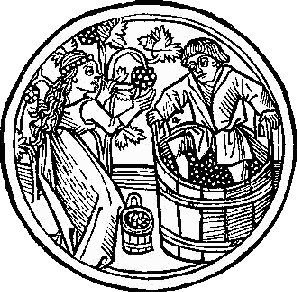Renaissance Cooking & Recipes
Renaissance Food . Recipes . References
 ood in the Renaissance was
very similar to what we eat today. People ate roasted meats, fish,
and bread. They had carrots, beets, melons, apples and a variety of
legumes. They
drank beer and ale (typically a weak watery small beer), wine
and cider. The wealthy could afford any variety of imported goods:
spices, citrus, sweet sherry or madeira.
ood in the Renaissance was
very similar to what we eat today. People ate roasted meats, fish,
and bread. They had carrots, beets, melons, apples and a variety of
legumes. They
drank beer and ale (typically a weak watery small beer), wine
and cider. The wealthy could afford any variety of imported goods:
spices, citrus, sweet sherry or madeira.
Unlike today, there was no refrigeration save that of a cold root cellar. This meant that produce needed to be consumed as it came available or preserved by drying, pickling, salting or smoking. This made for a long hard winter until the spring harvest came in. Typically for the poor peasant this would mean eating whatever was just going rotten, and holding back the rest against the possibility of a late spring.
All households kept a garden, even in the City proper, although the City suburbs provided the majority of its produce.

Ale!
Here's good luck to the Barley Mow! Ale had been made for centuries using only water, yeast, and roasted-malted (sprouted) barley. There are no small number of songs which celebrate the barley harvest and rightly so. Water being thought unsafe to drink (and sanitation being poor), the low alcohol of Ale made it a safe drink. Only the very poor drank water. Records suggest a gallon of ale a day was not an unusual consumption for the well-off. Ale would spoil and needed to be drunk quickly. Large houses brewed ale once a week.
In the 1400s beer was introduced by adding hops. Hops made beer a bitter drink, increased the yield from a given amount of malt and helped preserve it. However the brewing process was more difficult. Breweries became larger and reduced the number of self-brewed alehouses.
Custom (and the Ale-makers) objected that hopps (that wicked and pernicious weed) adulterated good English ale. But by the 1500s both were common. Henry VIII drank both, although he commanded that no hops nor brimstone be put into his ale.
Fish!
England, as a small wet sea-faring nation, had no want for fish. Sea fish were transported all over the country, both that caught locally and those (herring) imported from Iceland. Religious observances meant fish was exclusively eaten on Fridays and Saturdays. Common sea fish included cod, haddock, mackerel, conger, and mullet. Freshwater fish included roach and dace. Shellfish comprised part of the diet, with oysters the most common, mussels, cockles and winkles less so. There were also eels of the "jellied eel" fame. To preserve them, fish were often pickled, smoked, salted or dried. Live fish were transported inland wrapped in wet grasses. Monesteries and manors kept fish ponds.
Grain!
Various grain and peas were commonly planted. For the wealthy landowner, wheat was the desired crop for baking into fine bread. But due to the risks of blight or drought, multiple crops were planted: wheat, oats, rye and barley in addition to peas and beans. Barley could be made into both bread and ale, rye into rough bread, either into porridge, and oats made into hard cakes or fed to the horses.
Wheat and rye were planted after the autumn harvest, the rest in the spring.
Vegetables!
Elizabethans ate many of the same vegetables we eat today. They enjoyed the rich flavor of onions, leeks, garlic and mustard greens. They planted carrots, turnips, cabbage, radishes and parsnips. While the spices we know today were rare and expensive (pepper, nutmeg, etc), a large variety of herbs were grown locally: sage, mint, fennel, parsley, basil, marjoram. Sweet herbs were used as we used them now: to enliven otherwise dull dishes.
Fruits & Nuts!
Cold winter fruits were grown: cherries in the Spring, and apples and pears come Fall. Apples were eaten directly, baked or pressed into cider. Also grown were quinces and walnuts.
Dairy!
Many villagers kept some sheep or a (single) cow. Cream and milk was used when it was fresh, but most dairy was turned into butter or cheese.
Chickens!
Chickens and geese were commonly kept to produce eggs for use or sale. Young male chickens would be sold or capon-ized and eaten.
Meat!
Although a luxury, a common food among peasants was bacon. Pigs could live off of the leavings no one else would eat, and once slaughtered could be salted or smoked for preservation. Other animals provided such value (eggs, milk, wool, etc) that only in a time of wealth or plenty would they be killed. The final verse of the song "itches in me britches" contains the line: "there'll be plenty of love and bacon for the girl who'll have me now".
If you could catch it, you'd sell it or eat it. Four and 20 blackbirds, woodcock, pheasant, plover, thrushes, finches, herons even. Rabbits, squirrel, mice probably. Landowners generally frowned upon poaching by peasants and it was a common offense.
The slaughter of larger animals involved a large amount of work. The meat needed to be sold (and consumed) or preserved very quickly.
References

Index · Costumes · Acting · Language · RPFI · Education
© 1994-2015 Renfaire.com Contact Us